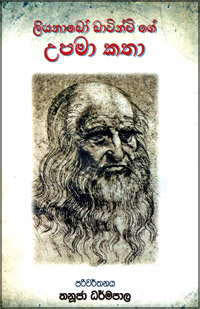Da Vinci Rediscovered through his Parables
Focus on Books
by Prof. Sunanda Mahendra
The name of the great Italian painter Leonardo Da Vinci (1452-1519)
became household after centuries since the appearance of the widely read
Da Vinci Code by Dan Brown.
 This novel became instantly popular due to several reasons. Some
literary critics were sceptical about the central theme of the work,
which presumably revolved round a religious factor, while some others
were in praise of the same as investigative reporting of an elevated
plane transcending the barriers of mere journalism. This novel became instantly popular due to several reasons. Some
literary critics were sceptical about the central theme of the work,
which presumably revolved round a religious factor, while some others
were in praise of the same as investigative reporting of an elevated
plane transcending the barriers of mere journalism.
This controversy reached a high point when the author had the chance
of selling his work around the world in millions making him a widely
read author when another book appeared with the title Secrets of the
Code by Dan Burstein. The latter attempted to trace some sources of
references as made in the former trying his best to dispel some of the
accepted views that promoted the work as a significant contribution.
Anyway, the intention here is not to get involved in this panorama of
views, but to introduce a rare book of the celebrated author and painter
Da Vinci in Sinhala, Leonardo Da Vincige Upama Katha (The Parables of
Leonardo Da Vinci; Fast publishers, 2007) translated from Russian by the
well-known journalist Tanuja Dharmapala.
In all, there are 40 mini creations with a vision by the great
painter. Perhaps it would have been fine if the reader was given the
awareness as to how these parables came to be known and created.
The reader finds that there are at least three main categories of
parables in this collection: firstly the inanimate type of characters
and situations making a world of make-belief where even inanimate
objects like pens, inkpots, and papers talk to each other, secondly the
animate characters other than humans like various types of animals,
devils and gods, which are more or less like the humans with experiences
resembling some of the parables of Aesop and La Fontaine where there is
a conventional pattern of knowing the moral behind without even hinting
at them, and thirdly the mere fantasy where the reader is made to enter
into a world of a sensitive creator - a world which links the ancient
and the modern thought stream with a thread of human understanding which
encompasses various human experiences in a wider vision transcending a
mere story telling manner.
Some of these parables have come to be translated into English as far
back as 1972 by Barno Nardine and the collection had been titled as The
Parables of Leonardo Da Vinci.
Though I have not come across the entire collection, I had the rare
chance of reading one or two of these parables in English as they
happened to be anthologised in a certain college reader in America. It
looks as if Dharmapala had taken much care to undertake the task of her
translation process from Russian to Sinhala.
The brevity as perhaps observable in the original is carefully
transformed into the local Sinhala language and idiom with care neither
using a colloquial slang form nor a strict classical form. As such the
parables could be read with interest.
It is hinted that these parables have gone into the works of the
great painter Da Vinci as extra creative material that had supplemented
some of his themes in the seminal expression. He may have utilised a
special art form to express these parables in visuals but there is no
trace of such a process as observable from the source that lies before
us.
This collection could be cited as a rediscovery of his visionary
feelings that may not have gone directly into his well-known works of
visuals that remain as a human legacy par excellence. The great master
may have had the chance of creating these mini parables for a special
purpose like self realisation and that he had been accomplished with
some of the rare material from his past cultural sources.
The fact that Da Vinci had been a sensitive student of the nature and
mechanics that encompass, it is known through his biographers and this
is evident from his parables that come as imaginative sources for any
student interested in cross sections of varied forms of nature studies
such as biology, zoology, botany, environmental sciences and
philosophies like the metamorphosis and transience.
The young Sinhala reader who has the traditional intimacies with the
juvenile literary forms may perhaps consider this collection as a
welcome variant to his available literary and knowledge sources on the
basics of sciences.
The Russian writer Tolstoy with his great creative works such as War
and Peace had time to spare for the writing of parables for children as
a means of educating them. Thus we are reminded that the greatest of the
genius have had time to write parables down the centuries in this
manner.
It could be guessed that the genius Da Vinci, who was know as 'the
man of the renaissance' would have spared some of his time to write
parables not only for children but also for adults.
[email protected]
|

